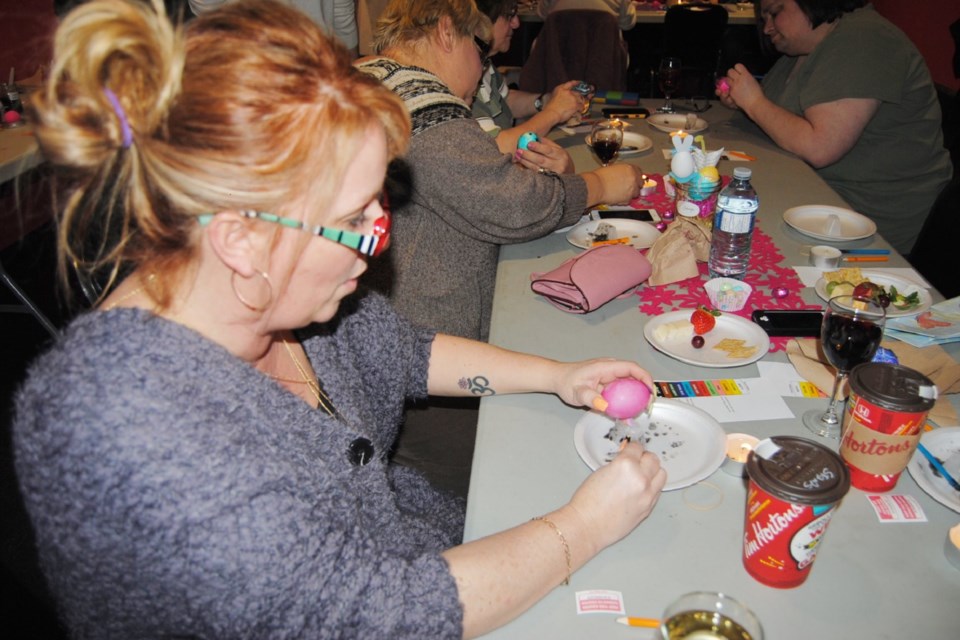Easter is fast approaching and you can never have too many Easter eggs to decorate your house or to use in Easter egg hunts.
Once again the Timmins Museum held its annual Pysanka Ukrainian Easter egg painting event.
A pysanka is an egg decorated with traditional Ukrainian folk designs using a wax-resist or batik method. Pysanka means to write as the designs on the eggs are written in beeswax, not painted.
This year the pysanka Easter egg painting event was part of the museum’s new Adult Thursday program featuring activities geared towards adults.
The cost for the class was $10 which covered the price of the material and two glasses of wine.
This is the fourth event in the Adult Thursday program which began in January. Previous events have included a session on felt making, flower arrangements and a talk by photographer Carlo De Lorenzi.
Megan Sinclair is the museum’s Program Coordinator for the Adult Thursday program.
Sinclair herself is relatively new to Timmins. She grew up in Sault Ste. Marie and London, Ontario before arriving in Timmins.
This is her first pysanka so it is as much a learning experience for her as it is for many of the 40 people, mostly women who attended last Thursdays event.
“Adult Thursday is a fun night out,” Sinclair said. “If they want to learn a cultural craft, this is a great event.”
“It is close to Easter,” she added. “And decorating an Easter egg is an appropriate activity.”
“The pysanka Easter egg painting has been around since before Christ - it’s origin is pagan,” explained Sinclair.
In pre-Christian Ukraine the people worshipped a sun-god and the bird because it flew so high in the sky was viewed as sacred.
“The egg became a sort of magical thing that the people admired,” Sinclair said.
Archaeologists have found fragments of colored shells with wax-resist decoration on them in Ostrówek, Poland near an ancient Ukrainian settlement.
Since Ukraine was converted to Christianity in 980 A.D. the tradition has continued with Christian meaning and symbolism according to Sinclair.
In the Ukrainian tradition each colour and symbol has a meaning steeped in Eastern Orthodox tradition. Colours represent hope, wisdom and eternity.
Sheri Joanisse Grzela is one of the pysanka egg makers. She is sitting at a table with her friends with a series of brightly designed eggs.
The eggs are hardboiled. However, in the traditional method a raw egg is used.
“I should have coloured the egg one colour first,” Joanisse said of her colourful egg. “But I left the base underneath uncoloured and the colour should have been a deeper purple over here”.
“The colours will be more vibrant once I remove the wax,” she added.
“It seemed like a fun activity to do with the girls,” Joanisse Grzela responded when asked why she attended the pysanka egg colouring event.
“It’s fun and I will do it again.”
The first step in the pysanka egg method is write the wax on the portion of the egg that is to remain white. Then dip the egg into yellow, red, blue or green dye.
Patterns are added to the egg using a stylus pen. Examples of patterns were projected on the wall for the class to choose from.
Marlene, a woman in the class of Ukrainian origin recalled her family tradition.
“In a traditional Ukrainian Easter the family would get together and the decorate eggs,” she explained.
“When my grandmother used to do it she didn’t boil the egg, she put a pin hole in the egg and drained it,” she recalled. We painted the egg shell - it was very delicate and we had to be careful.”
“I have some but many broke over time,” she said. “They were very brittle.”
Pysanka eggs were made to be given to family members and friends. They were symbolic gifts of life symbolized by the egg. The egg must remain whole.
The eggs that the family received were displayed in a wooden basket in the home.
Families would give pysanka eggs to the priest, boys and girls, unmarried women and men. Some were placed on the tombs of loved ones.
The eggs were also placed near valued or cherished animals such as cows, horses, hens, bees and were thought to protect them, keep them healthy and productive.



